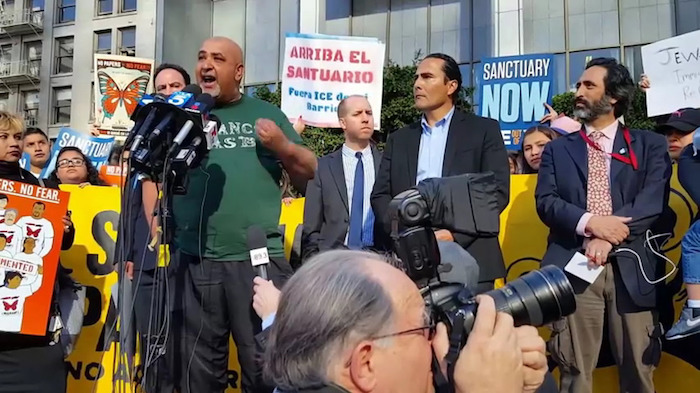“Nursing homes must have a plan to support residents’ right to vote,” according to an October 5 memo from the Centers for Medicare and Medicaid Patients.
But advocates of older adults and people with disabilities are worried those rights are not always met, especially in the wake of the pandemic. And the right to vote is only one in a long list of long-term care residents’ rights, including the right to health care and the right to quality of life. With the highest COVID-19 fatality rates of any group and the toxic effects of prolonged isolation due to pandemic quarantines, older adults, people with disabilities, and their advocates are working with the Office of the Long-Term Care Ombudsman to make sure those rights are met. A briefing by Ethnic Media Services discusses these challenges.
Blanca Castro, State Long-Term Care Ombudsman
EMS: How many residents are there and what is your concern as a state Ombudsman of long-term care about the issue of Rights?
BC: I am the state long-term care Ombudsman in California, that’s a Swedish word and it means advocate. There are about three hundred thousand people on any given day in California who whether or not they are there for the short term after surgery, maybe they have hip surgery, maybe they have heart surgery, but they go into nursing homes. For the most part, we have about 2000 nursing homes in California and then statewide we have almost 12,000 long-term care facilities, which are assisted living facilities, and include residential care facilities, and some of them are continuing care communities. So you may start out independently and then you will progress to more advanced care if you need 24/7 care. It’s important to note that when you are in a skilled nursing facility there are three ways to pay for your care; Medicare pays for the first hundred days and if you need a longer stay for your health you either pay through your health plan, you might have a private plan or are lucky to have long-term care insurance or medical, the Medicaid Program pays for it which requires many people to either remove many of their assets so that they can become eligible for Medical and the people that are in long-term care facilities who are not able to pay on their own or don’t have long term care insurance and are low income. What’s important to know is that just because you go into a nursing facility or long-term care facility you are still the same person you were before you entered. You still have a name, you still have family, you have a history, you have life experiences, you still matter, and the role of the long-term care ombudsman is basically to ensure that if somebody is not being given the level of care and being treated with respect and dignity when they are in a long-term care facility that we will come, will communicate with the resident; we are here specifically for the resident. What makes our work unique is, we are not an insurance agency. There are over seven hundred long-term care Ombudsmen across California, 35 programs statewide and we are funded entirely statewide by taxpayer funding. That is through the Older Americans Act and through the Older California funding so your taxpayer dollars go to caring for individuals who are in long-term care settings. As I said, some people are there short-term some are there long-term but what we want to talk about today is that every individual in a long-term care facility has rights that must be protected and must be honored. For example, if you are being forced to eat at a certain time or you’re not being given a bath when you want it, or when you press a call button because you need assistance going to the restroom and you’re not having somebody come in and help you in a timely manner or if they ignore you and it’s been hours, those are your rights. So as advocates of long-term care, ombudsmen get calls. Last year in 2021 we had almost 40,000 complaints. They range from inappropriate discharges to medications not being given, to anything like not having visitors. In a nutshell, we are your voice, we are there to work with staff and we are also there to work directly with the enforcement agencies, various agencies including the Department of Public Health, Department of Social Services, and Department of justice; whatever the situation is, we will find a way to try to work with administrators and staff. The main question we ask the resident by name is; “what do you want? what does resolution look like to you?” and then we go from there. Do we always solve every single situation? Absolutely not, but our goal is that, dignity, respect, and independence are always first and foremost and that the individual is able to communicate directly with us. They may be unable to communicate verbally, they might have a power of attorney or representative; we will work with their family. So there is a 1 800 crisis line and anybody can call the long-term ombudsman. It’s important to know if somebody is complaining, one of the unique things is that we are for the resident. If that individual refuses and does not give their consent for us to investigate or for us to raise a problem we have to honor that. So we are there for the resident unless it is very egregious physical abuse and somebody is in serious danger then we bring in law enforcement. But we have to always ensure that the resident has given us consent and we are providing them with the level of support that they are asking us to provide them.
EMS: What brought this on and made you take this so seriously?
BC: We are social animals, we need touch, we need a voice, we need contact. Unfortunately, because there was so much information out there, some that were science-based, some that were not, facilities were essentially locked down so residents became prisoners and for all intents and purposes, they were not allowed to go out, or to have any visitors. What has taught us and kept us up at night is that it doesn’t have to be that way. What we learned from the pandemic is that every long-term care facility as a requirement must have an infection control plan in place. For every individual that works there, or visits, there are protocols to ensure that if there is an infection how do you mitigate it, and how do you prevent it from spreading? Some of those things were not being done such as washing hands in between caring from one resident to another, making sure the same towel is not being used from one resident to another, and ensuring a mask is being worn if someone feels like they have a cough and chooses not to go in at all. There are now very specific recommendations and requirements for all facilities that must be maintained. That’s what the regulatory agencies are checking on but what we did learn is that the isolation not only did more harm, the fact that people were unable to see their loved ones actually made their conditions worse. Many people who had maybe early-onset dementia became much more severe at the end of the pandemic. People who already had some chronic conditions may have died earlier. How many people were unable to put closure on their loved ones as they were passing from life to death? What we learned is that it is not a policy and that there is no way to run what is part of the long-term care and healthcare system. We have now in place very specific laws, one that was passed this year, A B 895 does require that upon admission a resident must know the name of the contact for the long-term care Ombudsman, and then we had another law passed that requires during a public health emergency that Ombudsman will not be prevented from entering the facility.
EMS: Is there a bill of rights and where do we find this information?
Hagar Dickman, Staff Attorney, California Justice in Aging: The law that regulates nursing homes is actually the nursing home Reform Act which is a federal law that applies to every nursing home that is certified to accept payment for Medicare or Medicaid. Most nursing homes are regulated by the nursing home Reform Act Foundation and only the Reform Act requires that each nursing home provide the care needed by a resident to reach their highest practicable level of functioning by providing all necessary and appropriate care for particular residents or in other words person-centered care that is guided by and respectful of what each resident or individual needs, and what they want. Some of the rights that are contemplated by the act are, for example, all residents are entitled to the same level of high-quality care services of other residents regardless of the form of pay, which means that a Medicare resident is entitled to the same as a Medicaid resident is entitled to. A nursing home must provide all the nursing care and can’t say, “we don’t have financing for the kind of care that you need so you need to pay for your own private duty aide”.
Nursing homes also have to develop comprehensive person-centered care plans with the full participation of residents and their families that are routinely reviewed and revised to reflect residents’ needs and wishes. A nursing home can’t create a nursing care plan without actually discussing it first with the family of the resident. Care planning meetings have to schedule at times that are convenient for the resident and for the family members. Nursing homes have to make reasonable adjustments for resident needs and preferences to reflect the resident’s voice and provide person-centered care.
EMS: How well are these rights being enforced?
Hagar Dickman(HD): As with most laws there is always a difference between what times are available and unfortunately enforcing these rights falls to residents and their family members. Enforcement requires awareness of the rights, familiarity with processes for enforcement, and the confidence to pursue that enforcement without fear of retaliation.
EMS: How worried are you about vaccines and boosters in nursing homes and long-term care facilities? What is the difference between nursing homes and long-term care facilities
Dr. Anna Chodos, Associate Professor of Medicine, General Internal Medicine, Zuckerberg San Francisco General, UCSF and Geriatrics, Medicine, UCSF: Most people are confused and I would include most Healthcare Professionals. I just want to quickly identify that I do clinical care in clinics so I’m an outpatient doctor most of the time for the covid response. I was incredibly privileged to be able to be a part of that for our City and County of San Francisco and was doing nursing home and assisted living so there’s crossover there in terms of some of the issues. Briefly, assisted living facilities or residential care facilities for the elderly. From my perspective as a physician, they often have the same people. Old people, very frail or people who have a lot of care needs do end up in either. However skilled nursing facilities often have this acute rehab component, they have often more functionally or physically and cognitively disabled people. We however don’t have a systematic way of deciding what people need and where they end up and a lot of it has to do with resources, what’s available at the time, or what someone can afford. It’s a big mix of stuff, and nursing facilities are regulated by the Department of Public Health, the Center for Medicare and Medicaid Services, and then the Calvary Department of Social Services. Medically we see a lot of the same issues. Risks are very similar meaning communal living individuals with a lot of predisposing factors to serious illness. Vaccines completely turned the ship around in terms of how serious the risks are to these adults. People not getting vaccinated for covid-19, and not getting boosted adequately do put people at risk.




